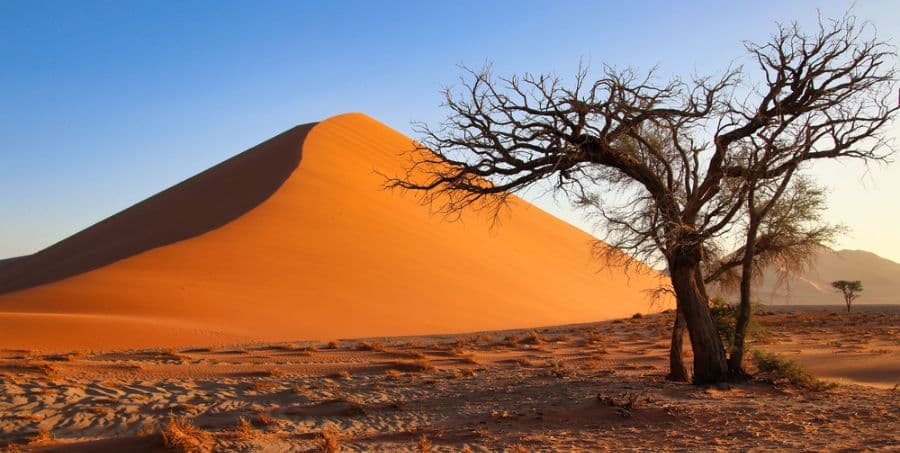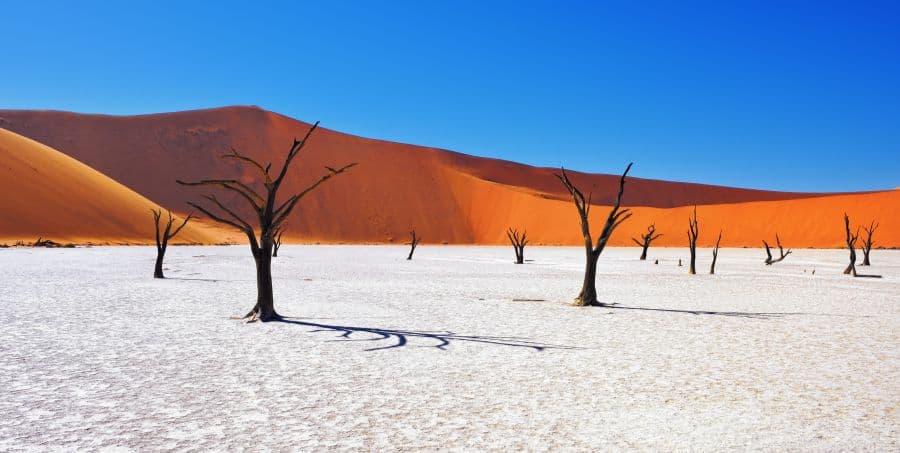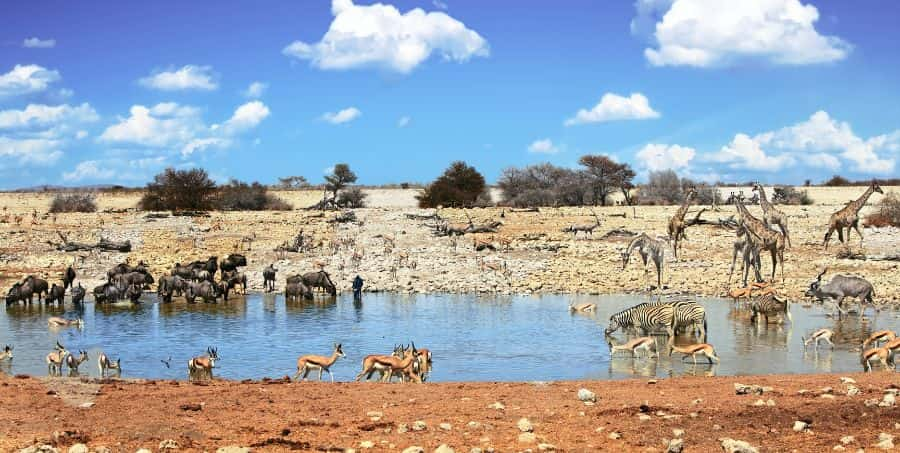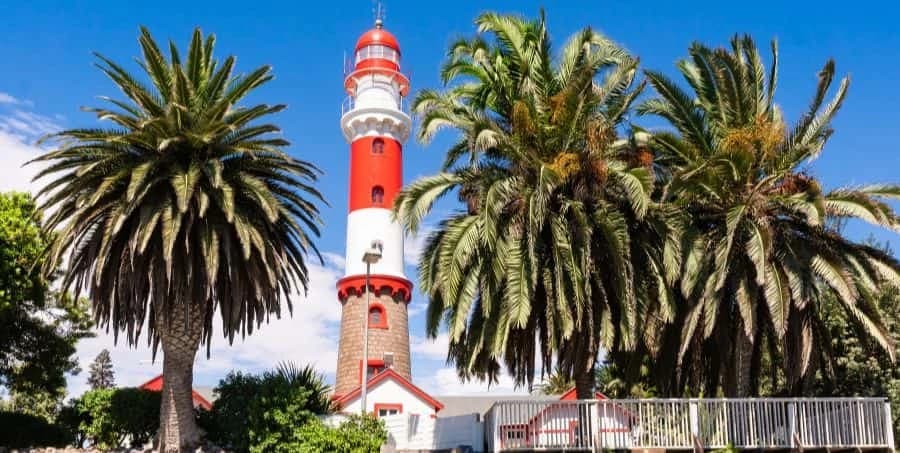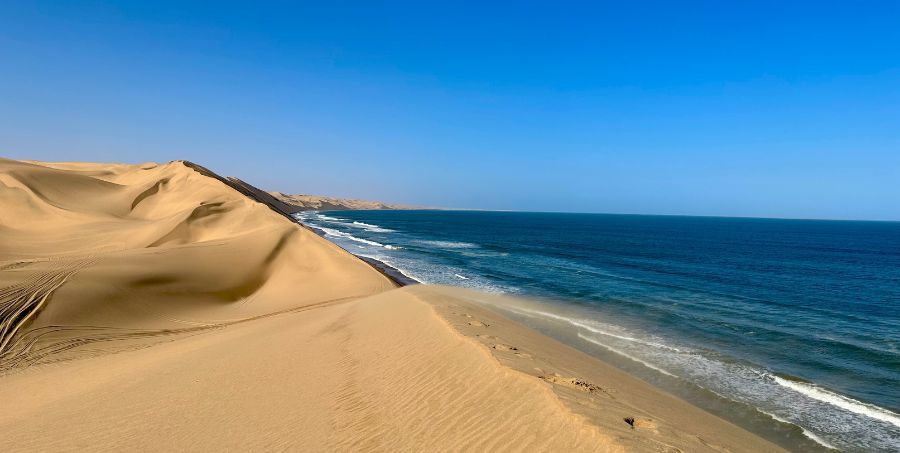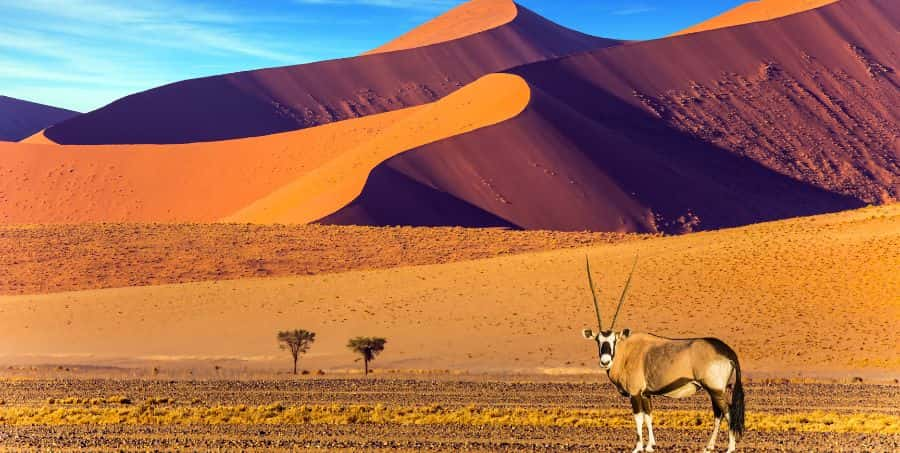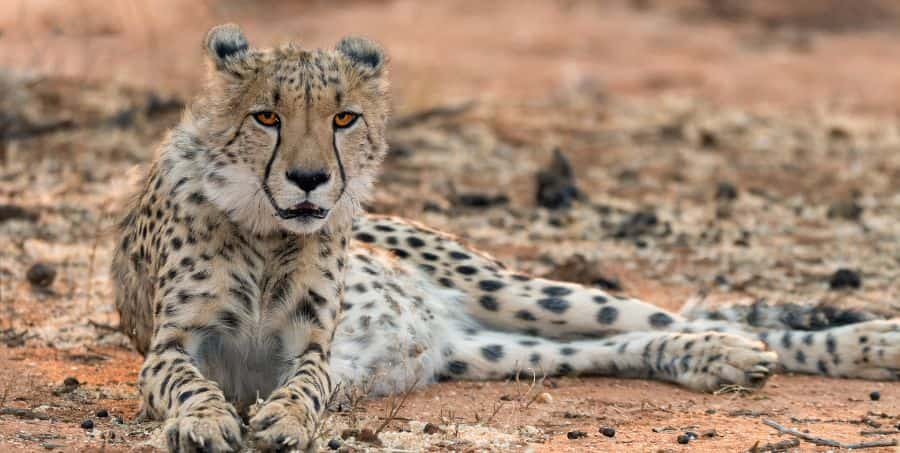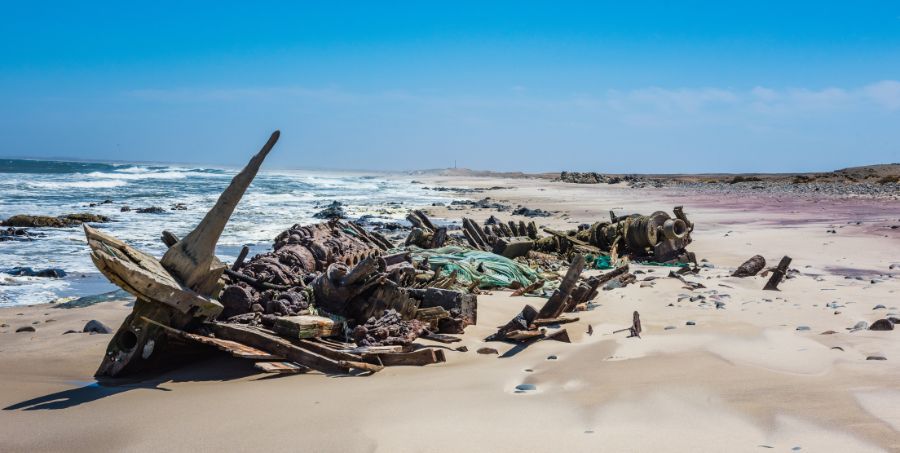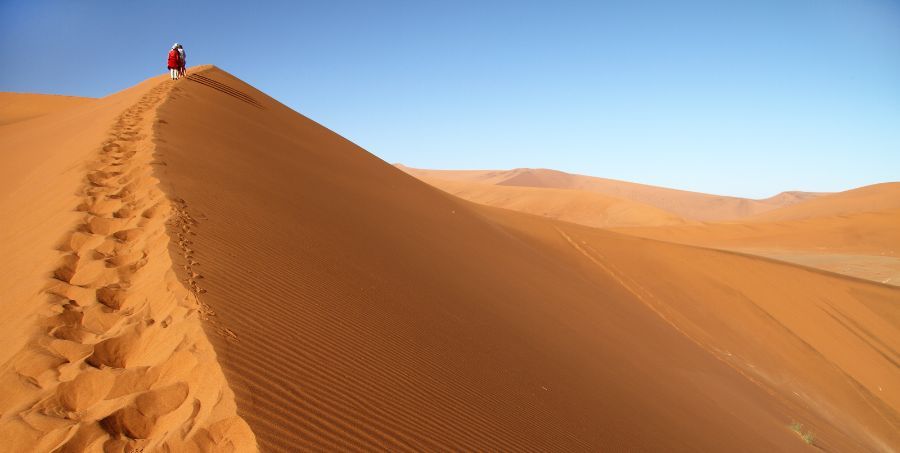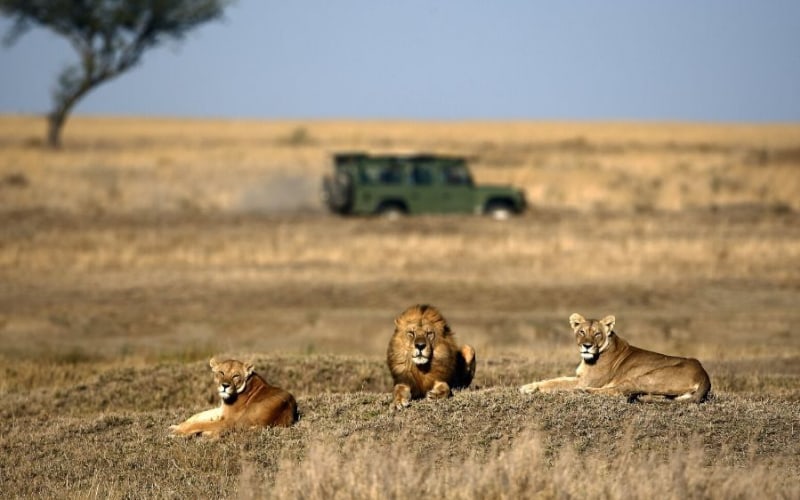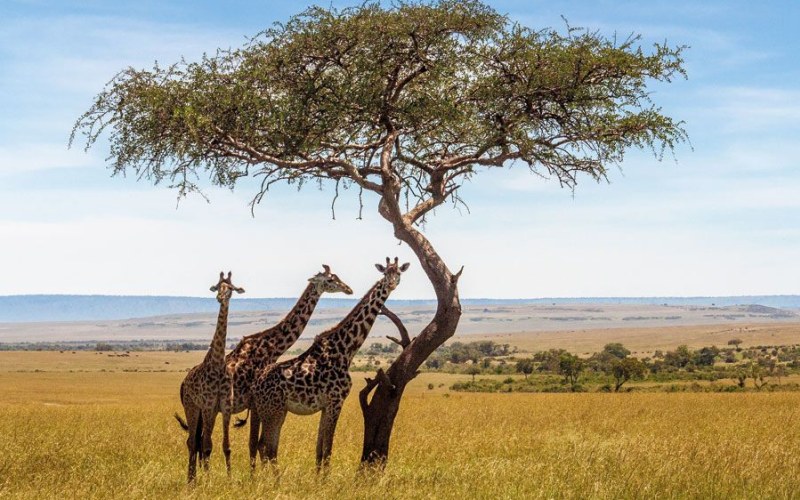If you want to experience wilderness, incredible wildlife and some of the most stunning scenery in the world, then look no further than Namibia. This vast, sparsely populated country offers a distinctive and memorable travel experience. Its dramatic landscapes have even caught the eye of Hollywood – Namibia has served as the backdrop for major productions such as Mad Max: Fury Road, Flight of the Phoenix and Dune: Part Two. Check out our suggestions for the best places to visit – and don’t be surprised if it inspires you to book a holiday to this remarkable African destination.
Best Places to Visit in Namibia
Sossusvlei
Located in the heart of Namib Naukluft Park and the biggest conservation area in the country, Sossusvlei – also known as the ‘Dune Sea’ – is possibly Namibia's most famous landmark. It has some of the biggest red dunes on the planet, and here you’ll also find the world’s most photographed dune, Dune 45. If you’re feeling active, you can climb the highest dune in the area, ‘Big Daddy’, at 325 metres (over 1,000 feet)!
Deadvlei
Next to Sossusvlei is a dry clay pan called Deadvlei. It is home to several dead Kamelthorn trees dating back 300–400 years. The name Deadvlei means "dead marsh" and is now a dried white clay pan. As the area is so dry, the wood does not decompose, and the trees appear black, scorched by years of intense sunlight.
Etosha National Park
Spanning an area comparable to the Netherlands, Etosha National Park is Namibia’s largest protected area, best known for its vast white salt pan – so immense it can be seen from space. It offers exceptional wildlife viewing, including some of the continent’s largest elephants, along with endangered black rhino, lions, leopards and cheetahs
Damaraland
Damaraland is a region in central Namibia renowned for its rugged and harsh environment. It has more than 40,000 Bushmen rock art and the famous desert-adapted elephants and rhinos can be found here. Remarkably, desert elephants can only be found in two places in the world – and one of them is Namibia – making this an incredibly special wildlife encounter. The desert elephants have adapted to this harsh environment throughout the years by having smaller bodies and larger feet to cover more land in search of water. All wildlife in Damaraland are free roaming. Also, the biggest mountain in Namibia is located in Damaraland.
Swakopmund
Swakopmund is a coastal town nestled between the Atlantic Ocean and the Namib Desert. Swakopmund is famous for its colonial German architecture, streets lined with palm trees, pleasant weather throughout the year and of course it offers endless adventure activities. On our Namibia holidays, we offer optional excursions in Swakopmund, such as the Sandwich Harbour tour, where you can take a four-wheel drive through the lower Kuiseb Delta hummock into Naukluft Park. You can also take a guided tour of Mondesa Township to meet local people, learn about their community projects, and gain insight into daily life – a wonderful way to experience Namibia’s rich cultural diversity and heritage.
Sandwich Harbour
One of Namibia’s most surreal and unforgettable sights can be found at Sandwich Harbour, near the coastal town of Swakopmund. This is one of the few places on Earth where the towering sand dunes of the Namib Desert tumble directly into the Atlantic Ocean – a dramatic meeting of desert and sea that feels as though it’s been lifted straight from the pages of a Wilbur Smith novel.
Namib Desert
The Namib Desert is one of the oldest and largest deserts in the world. It stretches for 2000 km along the Atlantic Ocean. The dunes closer to the coast are called the sand sea and became a UNESCO World Heritage Site in 2013. Being one of the oldest deserts, several mammals, snakes, spiders and bird species have adapted to the hot and dry environment.
Okonjima
Nestled among the “Omboroko Mountains” lies Okonjima – a Herero name meaning “Place of the Baboons”. This is much more than just a lodge; Okonjima is also home to The AfriCat Foundation. Namibia has the world’s largest wild/free-ranging cheetah population; the majority of the country’s cheetahs and leopards can be found on approximately 7000 commercial farms. AfriCat has had to take on a large number of captive cats no longer wanted by other establishments. Among the animals being rescued, researched and rehabilitated by AfriCat are cheetah, leopard, lion, caracal, wild dog and hyena. AfriCat has saved more than 1080 creatures since 1993 and 86% have been released back into the wild. Here you can have close encounters with these magnificent animals.
Skeleton Coast
One of the most otherworldly and remote parts of Namibia, the Skeleton Coast is where the Atlantic Ocean crashes into towering dunes and endless desert. With shipwrecks, seal colonies, and eerie fogs, it’s a surreal and unforgettable landscape. This wild coastline is now a highlight on our new tour – and for good reason.
What sets Namibia apart from other African countries?
Namibia stands apart in Africa for its sheer scale, solitude, and striking natural beauty. Once a German colony, it sits on the southwest coast of the continent, bordered by Angola, Zambia, South Africa, and Botswana. With a population of just over two million and a land area of 824,000 square kilometres, Namibia is one of the least densely populated countries in Sub-Saharan Africa – immense even by African standards.
Namibia doesn’t follow the pattern of large-scale tourism. Instead, you’ll find intimate lodges, small group tours and locally run camps – all set within unspoilt landscapes. While South Africa has more established tourist routes, Namibia offers something entirely different – vast, untamed landscapes, raw beauty, and a slower, more meaningful kind of travel. This simple infrastructure and its focus on sustainability make it more expensive than some of its neighbouring countries, but it’s a price many are happy to pay for such a rare and personal experience. It’s also considered one of the safest countries in Africa for travellers, thanks to its political stability, low crime rates in rural areas, and welcoming communities.
Ever-changing landscapes to explore in Namibia
In Namibia, the scenery is constantly shifting – it’s one of the few places in the world where you can witness such dramatic contrasts in a single day. Namibia also boasts some of the least polluted skies in the world – ideal for stargazing. Part of the country’s allure lies in its four distinctive landscapes, each with its own unique characteristics and attractions:
- The Namib – A long coastal desert that runs the length of the country and is the most significant of the four.
- The Central Plateau – Divided between rugged mountain ranges and sand-filled valleys.
- The Kalahari Desert – A vast desert of ancient red sand and sparse vegetation.
- Kavango and Caprivi – Blessed with tropical forests, perennial rivers, and woodland savannahs.
Incredible wildlife & safari experiences
- For wildlife lovers, you can see the Big Five in Namibia, although buffalo are only found in the lush Caprivi Strip in the northeast.
- It has an abundance of National Parks and private game reserves, showcasing exceptional biodiversity.
- Namibia has the largest cheetah population and is one of only two countries in the world which have the desert elephants.
- The country is also a leader in black rhino conservation, with one of the strongest remaining populations in Africa.
- If you’re looking to visit Africa for the first time and want to experience an African safari, Namibia is perhaps the perfect introduction.
A pioneer in sustainability
- After gaining independence in 1990, Namibia became the first African country to enshrine environmental protection in its constitution.
- It pioneered community-based conservation, allowing local communities to manage natural resources and benefit directly from tourism.
- This approach supports fragile ecosystems, protects endangered species like the black rhino and desert-adapted elephant, and helps preserve traditional ways of life.
- Namibia is also home to diverse indigenous cultures, including the Himba, Damara, San Bushmen and Herero – each with a deep-rooted connection to the land.
Experience the top places in Namibia with us
Explore Namibia on a small group guided holiday – one of Africa’s top safari destinations. Travelling in a smaller group allows for better wildlife viewing, more flexibility, and a richer, more personal experience. A guided tour of Namibia would be the best and easiest way to explore this incredible country; plus flights, accommodation, transfers and guided excursions all included.

